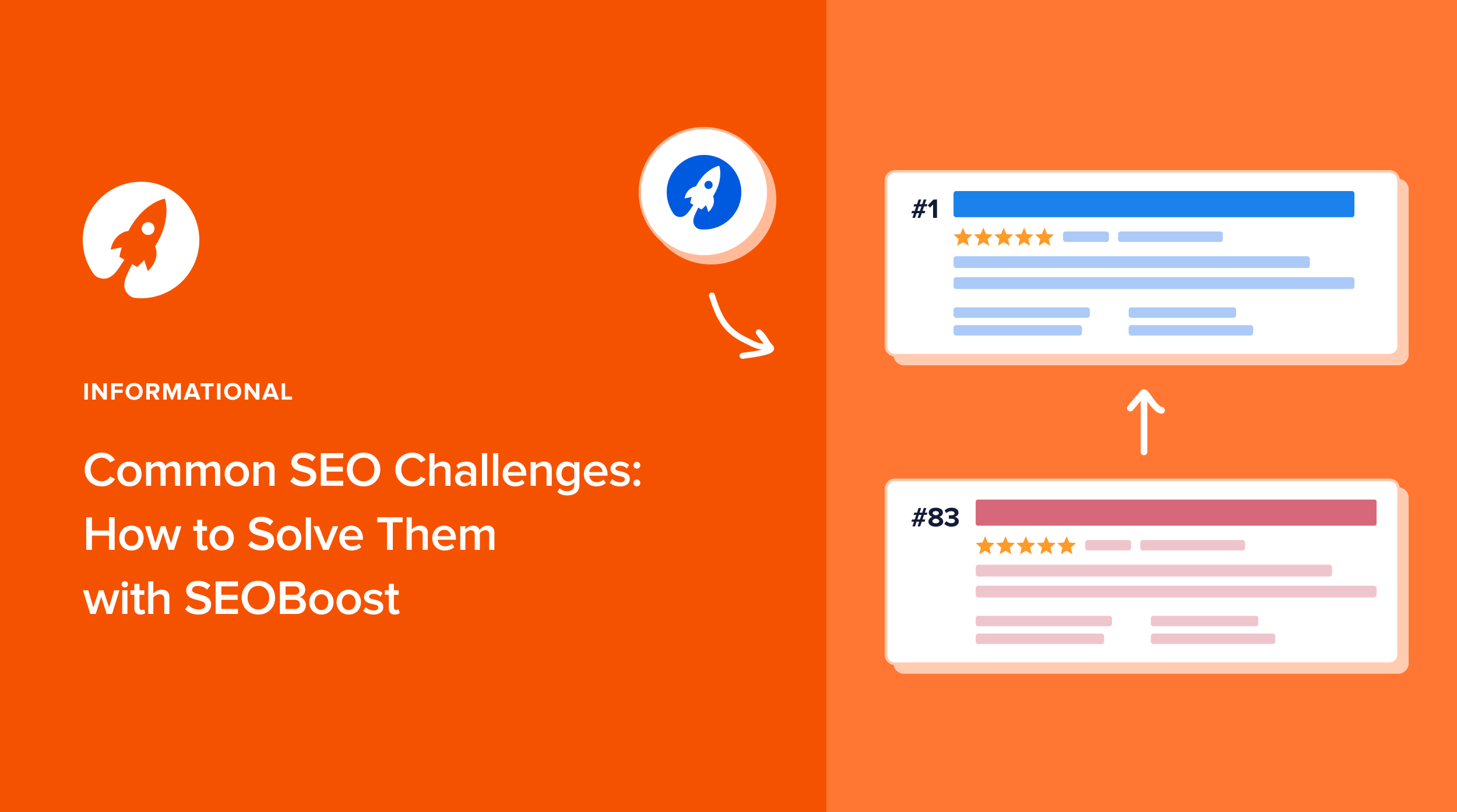Handling SEO challenges can often feel like trying to hit a moving target. Just when you think you’ve nailed it, Google decides to roll out a new algorithm update, or a competitor publishes a killer piece of content that bumps you down the rankings.
The truth is, SEO is a constant battle against challenges that can be overwhelming if you’re not equipped with the right tools. From choosing the right keywords to optimizing your content and building backlinks, there’s always something to improve.
But here’s the good news: SEOBoost can help you tackle these SEO challenges head-on.
In this guide, I’ll walk you through the 8 most common SEO challenges and how you can solve them using SEOBoost’s features.
Let’s turn those roadblocks into stepping stones.
How Does SEOBoost Help With SEO?
SEOBoost is your all-in-one SEO toolkit designed to simplify the complex process of optimizing your content for better rankings.
Whether you’re struggling with keyword research, content creation, link building, or technical SEO, SEOBoost offers features that streamline the entire process.
Here are its 5 winning features that help you with SEO:
- Topic Reports: Helps you uncover high-performing keywords, competitor strategies, and content gaps.
- Content Briefs: Guides your content creation process to ensure it’s optimized from the ground up.
- Content Optimization: Improves your content’s quality, relevance, and structure for higher rankings.
- SEO Content Audits: Monitors content performance and identifies opportunities for improvement.
- Content Management: Helps you organize, streamline, and manage multiple content projects efficiently.
8 Common SEO Challenges and How to Solve Them With SEOBoost
Now, that you have a better understanding of how SEOBoost helps, let’s tackle the most common SEO challenges one by one.
1. Difficulty Targeting the Right Keywords
If you’re targeting the wrong keywords, you might as well be throwing darts in the dark. Many businesses fail to identify long-tail keywords that attract more relevant traffic, or they go after high-volume keywords that are impossible to rank for.
But with SEOBoost’s Topic Reports feature, you can solve this issue.
It helps you uncover a string of related keywords as well as other important metrics associated with your focus keywords. This includes relevant questions to answer and detailed SERP analysis.
You can also pair it with other keyword research tools like LowFruits. It’s a great tool for finding low-competition keywords.
Combining SEOBoost with LowFruits gives you a major advantage by identifying long-tail opportunities that others might be ignoring.
Once you have your keywords, you can use SEOBoost’s Content Briefs feature to create outlines.
It provides detailed briefs that guide your content creation process, ensuring you’re targeting the right keywords with the right keyword intent.
2. Slow Page Load Times
A slow website is like a bad first impression because it drives people away before they even get to your content.
Slow load times can hurt user experience, increase bounce rates, and damage your rankings.
If your website has a slow loading speed, you can perform a technical SEO audit using AIOSEO’s SEO Analyzer. Using this tool, you can quickly identify and fix technical issues affecting your load speed.
At the same time, you should also ensure your content is structured efficiently to avoid unnecessary load times. You can use SEO silos to do that.
You should also use compressed images, minimize redirects, and use caching plugins to reduce load times.
3. Algorithm Updates and SEO Changes
Google’s algorithms are like moving goalposts. Just when you think you’ve cracked the code, an update shakes things up.
Staying up-to-date with the latest changes is a constant struggle.
But one of the best ways of coping with SEO changes is to create high-quality content. With AI Overviews and other search trends, there’s a lot more focus on personalized, trustworthy content now.
To do that, you can use SEOBoost’s Content Optimization feature. Its AI-powered tool helps you align your content with SEO guidelines and on-page SEO elements.
It also analyzes the top-ranking competitors, so you can benchmark your content against them. Using these insights, you can optimize your content for the best possible on-page SEO score.
You should also regularly monitor your content’s performance, which helps you stay ahead of algorithm changes.
In fact, make it a habit to re-optimize or update old content whenever a major algorithm update rolls out.
4. Competition for Top Rankings
You’re not the only one trying to rank for your target keywords. The competition is fierce, and it’s only getting tougher. Without a clear SEO strategy, you can risk being buried under a mountain of similar content.
But with SEOBoost’s Topic Reports feature paired with the Content Briefs, you can continue to create better, more comprehensive content that’s optimized for specific keywords.
After you’ve analyzed your competitors’ strategies and identified content gaps using the 7 different types of reports in the Topic Reports feature, you can use that data to create an AI content outline.
You can also add subheadings and notes if you’re an editor or a manager. This feature makes team collaboration super easy and effective.
Using Content Briefs, you can structure your content more effectively, making sure you cover topics more comprehensively than your competitors.
5. Inconsistent Content Quality
Creating high-quality content is tough. Maintaining it consistently is even tougher.
Many businesses struggle with keeping their content engaging, relevant, and optimized for SEO. As a result, they end up publishing posts that lack content depth or coherence.
Here’s how my favorite features from SEOBoost help you solve this challenge:
- Content Optimization: Ensures your content is polished, well-structured, and SEO-friendly. It provides suggestions for improving readability, keyword placement, and overall quality.
- Content Audits: Helps you continuously monitor your content’s performance, so you can easily spot what’s working and what needs improvement.
- Content Management: You can organize all your content projects, making sure nothing slips through the cracks.
I’d advise you to regularly update your content with fresh statistics, insights, and improved structure, which can give it a major SEO boost.
6. Managing and Updating Large Volumes of Content
If you’ve got a large website, keeping track of all your pages can feel like trying to juggle with one hand tied behind your back.
Keeping multiple pages up-to-date, consistent, and aligned with SEO best practices is a massive challenge.
SEOBoost’s Content Management feature turns this chaos into clarity.
You can create content campaigns and projects using this feature. It makes grouping related articles (by topic, funnel stage, or SEO goal) into organized projects.
You can also assign writers and reviewers, set due dates, and track progress all from one dashboard.
Using the feature, you can also set a built-in task chaining. When you put a target keyword and campaign timeline, SEOBoost automatically generates sequenced tasks, from topic report creation to writing, internal review, content optimization, and approval.
Using the media library feature, you can upload and reuse images directly within the CMS. This ensures visual consistency and speeds up content assembly, which is helpful when handling dozens of articles at once.
Pro Tip: Make a habit of conducting quarterly content audits to keep your entire website up-to-date and aligned with your overall SEO strategy.
7. Lack of Backlinks and Link Building
Let’s be real: earning high-quality backlinks isn’t easy, and outreach can feel exhausting. But the secret to more effective link building lies in knowing exactly who to reach out to.
SEOBoost’s Outbound URLs in Topic Reports solves this exact challenge.
When you create a topic report for your focus keyword, you’ll see a curated list of outbound URLs that top-ranking content for that keyword is linking to. This instantly shows you who the industry leaders and most linked-to authorities are.
Once you see these highly-referenced domains and articles, you have a clear list of contacts for your outreach campaigns. These are the sites already proven to accept links or references — exactly who you should prioritize.
SEOBoost also displays the exact anchor texts used in outbound links. By understanding what anchor texts successful competitors use, you can better craft your anchor text strategies in your own outreach or guest posting efforts.
Knowing the top outbound sources in your niche allows you to foster targeted partnerships. You can approach these sites to contribute guest posts, collaborate on content, or even request direct backlinks, boosting your site’s credibility and domain authority.
Pro Tip: Reach out to websites linking to outdated or inferior content and present your superior, updated content as a better alternative.
8. Low Conversion Rates From Organic Traffic
Getting traffic is only half the battle. But, if that organic traffic isn’t converting, all your SEO efforts are going to waste. This is especially true if your content isn’t aligned with user intent or if your calls-to-action (CTAs) are weak.
With SEOBoost’s Content Optimization feature, you can solve this problem at the root.
It analyzes the top-performing content in search results for your keyword, helping you clearly understand what users expect when they land on your page.
By aligning your content more precisely with search intent and answering specific questions and addressing real pain points, you’ll immediately boost engagement and compel visitors to act.
Remember, high-converting content doesn’t just attract readers; it resonates deeply enough to guide them effortlessly toward conversion.
Pro Tip: Place CTAs strategically within your content to guide readers toward taking action. Make sure your content addresses their pain points effectively.
FAQs About SEO Challenges
What is the biggest challenge in SEO?
The biggest challenge in SEO is keeping up with constant algorithm updates and adjusting your strategy accordingly. Staying informed and adapting quickly is key.
What is the most difficult part of SEO?
One of the most difficult parts of SEO is link building. Getting high-quality backlinks from authoritative sites requires a lot of effort, networking, and content creation.
What is SEO difficulty?
SEO difficulty refers to the level of competition for ranking a particular keyword or topic. High-difficulty keywords are more challenging to rank for due to strong competition.
What are the benefits and challenges of SEO?
Benefits of SEO include increased organic traffic, better user engagement, higher conversions, and improved brand authority. SEO challenges include keeping up with algorithm updates, acquiring backlinks, and managing large volumes of content.
Final Word
SEO can be overwhelming, especially when you’re trying to tackle multiple SEO challenges at once.
But with SEOBoost, you’re not just solving these problems — you’re turning them into opportunities.
From keyword research and content optimization to tracking competitor strategies and improving conversions, SEOBoost equips you with everything you need to dominate the search results.
Ready to solve your biggest SEO challenges? Start with SEOBoost today.




